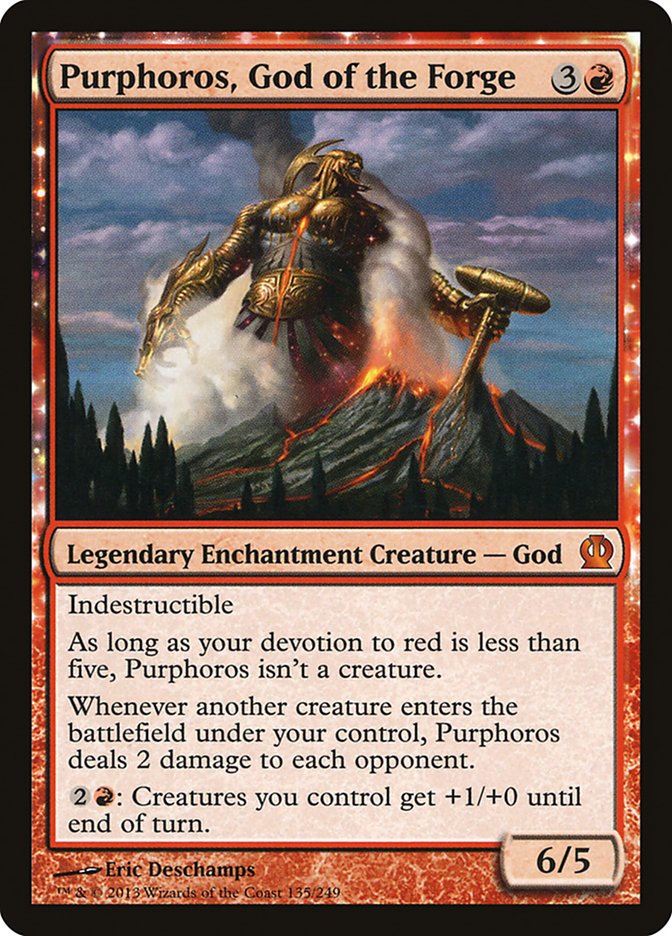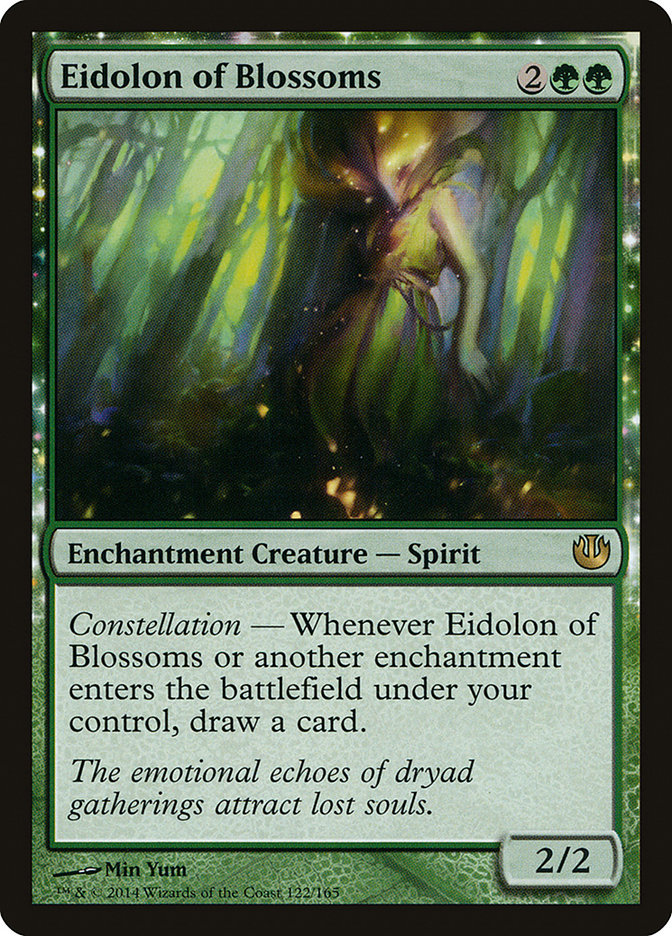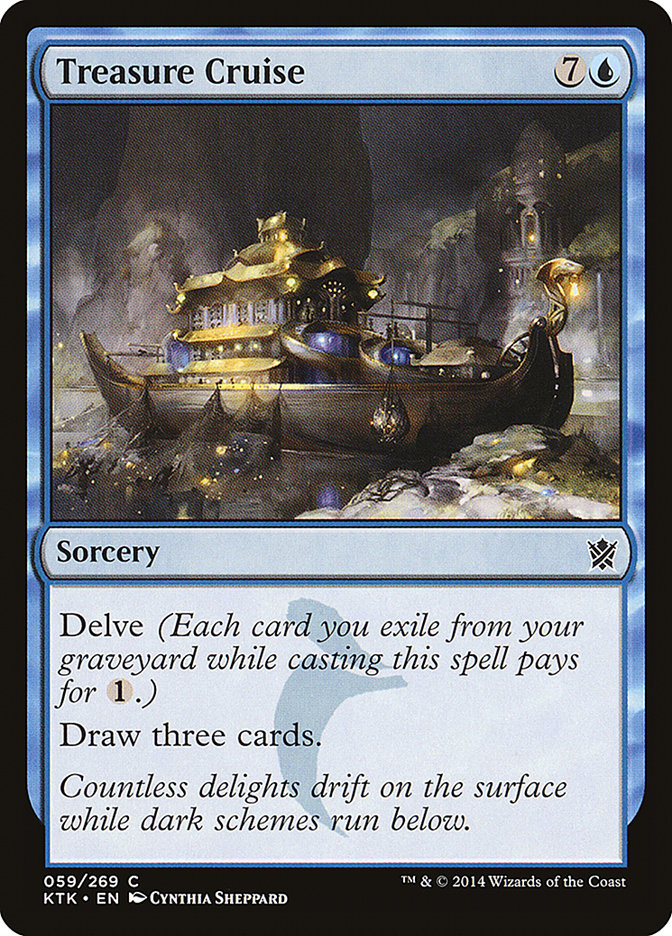The combination of Sylvan Caryatid and Courser of Kruphix have paved the way for a variety of strategies over the last two years, going so far as to
dictate the way aggressive decks are to be built in order to compete. At SCG DC, Gerard Fabiano showed the world that there is still room to innovate with
green’s card pool and capabilities, essentially splashing Satyr Wayfinder in U/B Control in order to super charge the deck’s card advantage engine and
support Tasigur, the Golden Fang. The talk of the tournament, however, was Frontier Siege showcased by the Roanoke crew, enabling another new toy: Ugin,
the Spirit Dragon. Although there is a great deal of appeal to casting an enormously powerful and splashy eight-mana planeswalker, one card from Fate
Reforged appeared to get rather little press:
Whisperwood Elemental has all the makings of a phenomenal card. Its initial rate is adequate, it generates value just by making it to your first end step,
and it has built in sweeper protection: a high value commodity in devotion strategies. However, the most intriguing aspect of the card is how it utilizes
manifest. For once, it’s worth going back to reevaluate older cards not for their enter-the- battlefield abilities but instead their morph costs.
How far is it possible to push a deck based around utilizing manifest?
Creatures (28)
- 1 Hornet Queen
- 4 Elvish Mystic
- 2 Purphoros, God of the Forge
- 4 Courser of Kruphix
- 3 Hornet Nest
- 4 Rattleclaw Mystic
- 4 Hooded Hydra
- 4 Whisperwood Elemental
- 2 Temur Sabertooth
Planeswalkers (2)
Lands (23)
Spells (7)

There are a lot of subtle things going on here. The clear big winner of manifest is Hooded Hydra. Being able to turn it face up for GG can create some
radical shifts in board position and again improves the resiliency of the deck towards sweepers, a factor that has becoming increasingly important with the
printing of Crux of Fate.
You might also notice some of my old favorites.
Although I have a self-proclaimed love for Hornet Nest, Setessan Tactics, and Purphoros, they’re up to some new tricks. Hornet Nest has never stopped being
great against aggressive and midrange strategies, with the ability to stop Heroes and Rhinos in their tracks. However, who’s to say a facedown Nest can’t
also join the beatdown party? Manifest is going to force a lot of tough decisions out of your opponents, and the first blow out will often create the
illusion of an incoming second.
Temur Sabertooth might appear to be a bit of an oddball, but after playing against it in Limited, it only took watching one game last week out of the Temur
Ascendancy combo deck to convince me that it has a place in Constructed. Although there is a real sacrifice in choosing to sleeve it up over Polukranos,
World Eater, Temur Sabertooth definitely adds some unique angles of attack. In addition to being great with Setessan Tactics and being able to pick up
valuable manifested cards, it makes a pretty convincing fireball impression with Purphoros and another cheap creature.
Speaking of which, Purphoros is firing on all cylinders with this deck. Hooded Hydra, Xenagos, Hornet Nest, Whisperwood Elemental, and Sabertooth are all
enablers that give me confidence it’s possible to burn out decks going over the top of you, a traditional problem for green midrange and devotion
strategies, and with the right draw, he can even get in the red zone sometimes!
Wildcall, and the centerpiece, Whisperwood Elemental, are our enablers with Wildcall serving as a card that scales up the curve. Manifest is designed
specifically in this deck to generate a lot more value, and fear, than simply a vanilla 2/2. Rounding out the deck are the usual suspects you would expect
to see in this type of strategy. I admit the miser Hornet’s Queen might be better suited as another land, but I couldn’t resist its power with Purphoros.
However, despite some awesome synergies and a lot of potential power and deception, I suspect that this deck may be bordering on a common problem in
brewing: being slave to a theme. Hooded Hydra and Hornet’s Nest are great cards to be placed face down, but they often suffer when they greet you in the
draw step. Further, despite the fact that manifest creatures are able to dodge Ugin, the Spirit Dragon’s minus ability, it is entirely possible that
Frontier Siege green decks can just leave us in the dust. We probably need a more cohesive plan.
As I touched on previously, it was seeing the Temur Ascendancy deck in action that sold me on Sabertooth, but I find the lack of Whisperwood Elemental to
be a real oversight. What if we were to blend the strategies a bit?
Creatures (30)
- 4 Elvish Mystic
- 2 Sylvan Caryatid
- 1 Purphoros, God of the Forge
- 4 Voyaging Satyr
- 4 Courser of Kruphix
- 2 Eidolon of Blossoms
- 4 Genesis Hydra
- 2 Reclamation Sage
- 4 Whisperwood Elemental
- 3 Temur Sabertooth
Lands (23)
Spells (7)

For those who aren’t familiar with the combo: seven green devotion, Voyaging Satyr, Temur Sabertooth, and Temur Ascendancy represent infinite mana. As well
as Mark’s deck was designed for SCG DC, I think rather than being a green devotion deck with an incidental combo, there’s a lot of room to push the deck
towards just being the superior Frontier Siege strategy. Hornet Queen and Ugin, despite their power, are vulnerable to simply not being castable. I’d
rather utilize cheaper cards that also serve as great mana sinks. We will never have trouble going nuts with Frontier Siege, using our mana every turn
despite “maxing out” at five.
I think there are two major points of interest with this list. First is Reclamation Sage. Despite being seemingly out of place, the sheer number of
enchantments seeing play in maindecks at the moment makes me believe that the quickest route to wrestling advantage back in Frontier Siege mirrors is
through maindeck Sage. I’m not even convinced that there shouldn’t be three in the starting 60. Additionally, its ability to be picked up by Sabertooth
gives a lot of control over controlling opposing mana development by making Coursers and Sieges difficult to stick.
Second is Eidolon of Blossoms. Despite there being even more enchantments than Mark’s list and the velocity the card grants, it’s hard to justify playing
more four-mana spells than we already do after adding Siege, and Eidolon has little value in the faster matchups. That being said, Purphoros is certainly
approaching “too cute” status here, and I could see it being cut for the third Eidolon.
As for the sideboard, these are largely the usual suspects. The day may have finally come that we no longer fear control decks. Between Sabertooth, Genesis
Hydra, Whisperwood Elemental, and then Xenagos and Nissa, we have a lot of great and diverse tools that can fight both Elspeth and sweepers. Frontier Siege
has even helped to alleviate the classic problem of losing your mana production to removal. Couple that with the ability to actually draw cards, and it’s
possible these types of matchups are actually favorable. My main concern is that the 75 doesn’t have a direct plan for Hornet Queen other than going
larger. The solution may simply be to play more of our own. Sabertooth helps to sustain Queen Bee advantage while also containing Doomwake Giants with our
Reclamation Sages.
I suspect we are still far off anywhere near an optimal build, but there’s something to be said about a deck that’s built to get on the board, has several
different options for card advantage and sweeper protection, and that can also go wide and perform a combo kill. I don’t expect people to be sleeping on
Whisperwood Elemental for too much longer, and there may finally be a shake up towards the Doomwake Giant/Hornet Queen dynamic that has defined Standard
green mirrors for the last several months. Frontier Siege has proven to be the real deal, and I believe this is one of the best ways to leverage it.
With the Pro Tour right around the corner, I unfortunately had to miss SCG Indy. So in closing, I want to touch on the bans and discuss a new card that I
feel isn’t getting quite enough love.
On Treasure Cruise:
I probably have a different stance than most on Cruise. Despite the absurd power level of the card and the push towards more linear high velocity blue
decks, there were some interesting benefits towards having the card in the format. As Cedric and Patrick touched upon in their podcast, a clear benefit of
Treasure Cruise in my eyes was the lack of Wastelands in Legacy. Although it was entirely possible for someone to pull ahead as early as turn 2 with
Treasure Cruise, the reality was that there was a lot more Magic being played. For two months I don’t think I played a single game where either myself or
my opponent died to being mana screwed by Wasteland, and that’s a good thing. Further, I won a lot less games at Grand Prix New Jersey than I would have
without Cruise in the format.
Treasure Cruise is extremely punishing and gives a lot of comeback power, forcing the player who may be extremely far ahead to tread carefully and use
their resources judiciously knowing that the top of their opponent’s deck may at any time contain the powerful sorcery. It forced me to play tighter and
encourage myself to never get too comfortable with the state of the game. I can’t say that for many cards, even if it is a subtle side effect. As for
arguments towards the inbreeding towards blue decks and the spike in Red Elemental Blasts and other splash damage in regards to the prevalence of Cruise,
blue decks have never and never will stop being a massive part of Legacy, and the reality of the situation is that most decks probably should have been
playing more Blasts to begin with. I suspect that trend will but should not change. The fact that Cruise players had to make a clear choice to include more
cantrips and other high velocity enablers in their decks made their lists weaker to combo and other folks willing to specifically target lean blue decks.
There was a real cost.
But now we live in a different world. Cruise is gone, but Dig Through Time has stayed. There will be a lot more Wastelands and push back towards the
popular Sultai strategies before Khans of Tarkir, which Jim Davis demonstrated this past weekend in Indianapolis.
What would I have played on week one of Cruise-free Legacy? Maybe not what most would expect, Miracles with a little twist:
Creatures (6)
Planeswalkers (1)
Lands (21)
Spells (32)

Monastery Mentor looks great to me. A big issue with Miracles in my mind that’s been alleviated to some extent in the last year was that it often had a
huge problem playing functional Magic without Sensei’s Divining Top. A push towards Ponder and a leaner curve has made the deck far more efficient. But the
other real problem I had with the deck was Entreat the Angels. Although it is powerful and can end the game on the spot, at later stages in the game, it is
only a win condition, a huge issue for a format as unforgiving as Legacy, but likely a necessary evil considering the plagues of the clock. Stoneforge
Mystic was a choice used in the past to help with this issue, but it requires playing other types of clunky dead draws, is vulnerable to cards that already
have applications against the Counterbalance combo, and acquires little value without surviving a whole turn cycle.
Young Pyromancer is an option but doesn’t actually encourage Miracles to play Magic in the way it desires. However, Monastery Mentor has the potential to
solve all of these issues. It builds board position with little effort, closes extremely quickly in the lategame with Sensei’s Divining Top (let alone
two), and picks up a lot of the fire that the Counterbalance + Sensei’s Divining Top combo would be under against Abrupt Decay decks. Although you could
argue that it is to some extent a non-bo in a Terminus deck, I can’t imagine ever being upset against creatures if Mentor is allowed to stick around. The
tokens themselves can square off with most of what the format has to offer.
The noticeable real cost here is the smaller number of Jaces. This is largely a nod towards the curve, and it is possible that the deck requires a second,
skimping on a Dig Through Time, but I would have felt confident playing it this last weekend.
Regardless of how successful Mentor is in a traditional Miracles strategy, I believe there is a lot of room for him to grow into the format; his ability to
trigger in just about any deck employing its noncreature-based strategy is unique an exciting, and again, I suspect that he won’t be slept on for long.
Where else do you think Monastery Mentor can see play in Legacy?







